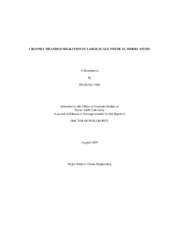| dc.contributor.advisor | Chang, Kuang-An | |
| dc.creator | Yeh, Po Hung | |
| dc.date.accessioned | 2010-10-12T22:31:43Z | |
| dc.date.accessioned | 2010-10-14T16:07:09Z | |
| dc.date.available | 2010-10-12T22:31:43Z | |
| dc.date.available | 2010-10-14T16:07:09Z | |
| dc.date.created | 2009-08 | |
| dc.date.issued | 2010-10-12 | |
| dc.date.submitted | August 2009 | |
| dc.identifier.uri | https://hdl.handle.net/1969.1/ETD-TAMU-2009-08-7215 | |
| dc.description.abstract | A set of large-scale laboratory experiments were conducted to study channel meander migration. Factors affecting the migration of banklines, including the ratio of curvature to channel width, bend angle, and the Froude number were tested in the experiments. The effect of each factor on the evolution of channel plan form was evaluated and quantified. The channel bankline displacement was modeled by a hyperbolic function with the inclusion of an initial migration rate and a maximum migration distance. It is found that both the initial migration rate and maximum migration distance exhibit a Gaussian distribution along a channel bend. Correlations between the distributions and the controlling parameters were then studied. Two sets of equations were developed for predicting the initial migration rate and the maximum migration distance. With the initial migration rate and maximum migration distance being developed as a function of geometric and flow parameters, a hyperbolic-function model can be applied to estimate the bankline migration distance.
The prediction of channel centerline migration was also developed in this study. The channel centerline was represented with a combination of several circular curves and straight lines. Each curve with the radius of curvature and bend angle was used to describe the channel bend geometry. HEC-RAS was applied to estimate the flow hydraulic properties along the channel by adjusting the channel bed slope. The intersections of two consecutive centerlines were found to be the inflection points of the centerline migration rate. Phase lag to the bend entrance was measured and correlated with the bend length and water depth. The migration rate between two successive inflection points demonstrated a growth and decay cycle. A sine function was used to model the centerline migration rate with regression analysis of the measurement data. The method was applied to four sites of four natural rivers in Texas. The results showed that the prediction equation provides agreeable results to the centerline migration of natural rivers. | en |
| dc.format.mimetype | application/pdf | |
| dc.language.iso | en_US | |
| dc.subject | Channel Meander | en |
| dc.subject | Meander Migration | en |
| dc.subject | Talweg | en |
| dc.subject | Secondary Flow | en |
| dc.subject | Scour | en |
| dc.title | Channel Meander Migration in Large-Scale Physical Model Study | en |
| dc.type | Book | en |
| dc.type | Thesis | en |
| thesis.degree.department | Civil Engineering | en |
| thesis.degree.discipline | Ocean Engineering | en |
| thesis.degree.grantor | Texas A&M University | en |
| thesis.degree.name | Doctor of Philosophy | en |
| thesis.degree.level | Doctoral | en |
| dc.contributor.committeeMember | Briaud, Jean-Louis | |
| dc.contributor.committeeMember | Chen, Hamn-Ching | |
| dc.contributor.committeeMember | Sherman, Douglas J. | |
| dc.type.genre | Electronic Dissertation | en |
| dc.type.material | text | en |


